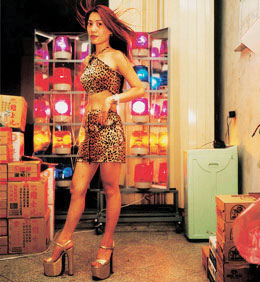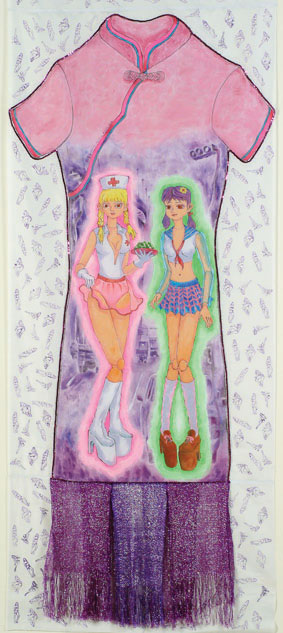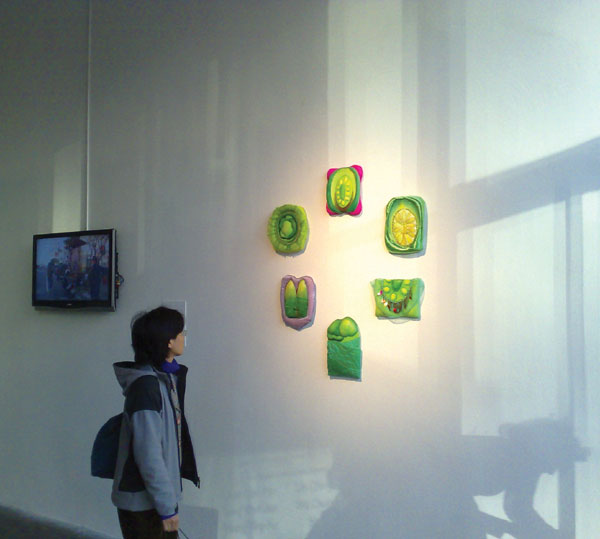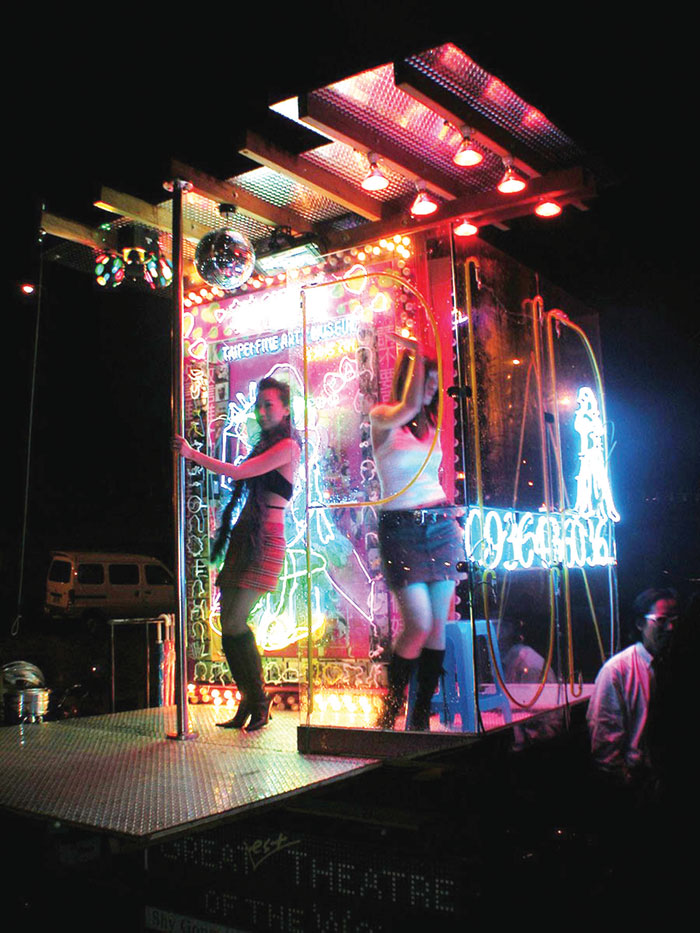Betel Nut Beauties Captivate Paris / 檳榔西施我愛妳 魅惑巴黎
The artists who have contributed to the exhibition are Ching-Fang Lin, Ting-Fu Huang, Chung-Hua Wu, Wen-Jen Deng, Ching-Pao Chen and Shygong. They have been observing the phenomenon of betel nut beauties for many years. Ching-Fang Lin, is still a student of the Graduate School of Plastic Art, National Taiwan University of Art. He sees betel nut beauties not only as pretty girls, but more like angels. Lin used "Taiwan Girl" as his theme and the betel nut beauty is a part of this Taiwan Girl series. In his "Saint Taiwan Girl-Betel Nut Angel", he adds a pair of angelic wings on betel nut beauties in his paintings. 
Lin says, the sight of girls in skimpy outfits in neon-lit glass cubicles is so odd that he cannot help but have a few looks every time he drives past them on the road.
Although the betel nut ladies in Lin's painting were portrayed as angels with wings, their faces were painted in an image of shattered glass. Lin says that it is because Taiwan Girl's behaviour always shatters people's fancy toward them- when you look closer, these girls are always wearing wall-thick make-up, or are being foul mouthed." But Lin thinks this is the revelation of their true selves.
The photographer Ching-Pao Chen, who is also a primary school teacher, has spent 8 years photographing betel nut beauties in northern Taiwan. He gathered the photos he took during 1996 to 2003 and published a photographic album titled "Betel Nut Girls".
What inspired Chen to photograph betel nut beauties was that when he was courting his then girlfriend, now wife, he used to chauffer her everyday passing through Jhonghe City in Taipei County. There were a lot of betel nut cubicles along the route and they caught his eye. Therefore, he decided to use his camera and capture this subculture which has already become a part of Taiwan culture.
 As Chen recalls, before he started shooting, he thought that these ladies in revealing outfits really clashed with Taiwan's conservative customs. Because he had talked to the betel nut shop owners and the ladies before he start photographing them, all the photos were shot with consent and were shot openly from the front angle. By doing so, Chen also built up a good relation of trust and had wonderful interactions with them. Therefore, he was able to explore further and gain a deeper understanding of the betel nut beauty culture. He thinks that betel nut beauties are a product of Taiwan's unique social environment. Although they are different, they should not be discriminated against.
As Chen recalls, before he started shooting, he thought that these ladies in revealing outfits really clashed with Taiwan's conservative customs. Because he had talked to the betel nut shop owners and the ladies before he start photographing them, all the photos were shot with consent and were shot openly from the front angle. By doing so, Chen also built up a good relation of trust and had wonderful interactions with them. Therefore, he was able to explore further and gain a deeper understanding of the betel nut beauty culture. He thinks that betel nut beauties are a product of Taiwan's unique social environment. Although they are different, they should not be discriminated against.
Another artist Wen-Jen Deng has been studying food and drink culture for the past few years. Her works are based on the original form and colour of food- this reflects her attitude toward betel nut beauties. She does not smear, praise, nor criticise them. She made semi-relief betel nuts by using materials such as fabric and acrylic pigments as well as gaudy elements representative of the betel nut beauties costumes such as glitter and sparkles. It looks as if the nut is saying "come eat me!"
Chung-Hua Wu sees the Chinese dress of Taiwan in early 20th century as a symbol of traditional Taiwanese females, and betel nut beauties as a symbol of new modern females. Her work is to combine Chinese dress, the betel nut beauties, and Barbie dolls. These 3 symbols together try to open a conversation of the ideology of modern women in Taiwan.
Ting-Fu Huang's contribution to this exhibition is a documentary of betel nut beauties. Shygong's design is a betel nut cubicle on an electronic floral cart. It represents the aesthetics case of the exclusive local culture of Taiwan. It also highlights the ironic clash and co-existence of high and low classes that exist in every society.
The exhibition "Betel Nut Beauties" is co-hosted by KMFA and Maison des Cultures du Monde. It started on 6th of March at the hall of Pont Ephemere in Paris. Among the 19 countries that have joined the 12th Festival de I'lmaginaire, seventeen of them are performing art groups. There are only two countries at this festival with art exhibitions and Taiwan is one of them. Through advertisements in the free magazine of Maison des Cultures du Monde, which is widely distributed in underground stations around Paris, the name of Betel Nut Beauties from Taiwan has been spread to every corner of Paris.
參展藝術家林慶芳、黃庭輔、吳瓊華、鄧文貞、陳敬寶及施工忠昊,他們都長年關注檳榔西施現象,在台灣藝術大學造形藝術研究所學生林慶芳眼裡,檳榔西施不但是漂亮的女孩,更像是天使。林慶芳曾以「台妹」為創作主題,檳榔西施是台妹系列的一環,「聖台妹:檳榔天使」系列畫作中,他為檳榔西施加上天使的翅膀。
每回經過省道時,霓虹燈屋加上清涼辣妹,在一片田野荒涼景色中,顯得有些突兀卻很醒目,停車時都不免多看幾眼,覺得很開心。
雖然,林慶芳畫中的檳榔西施都幻化成有翅膀的天使,面貌卻都如玻璃般的破碎,因為「台妹的行為舉止,常會令人感到幻滅,像是近看她們,粉都塗的很厚,或口出三字經」,不過,他認為這是「自然的流露」。
 攝影家也是小學老師的陳敬寶則是花了八年時間,從1996年至2003年間,以北部檳榔西施為對象進行拍攝,還彙集成「片刻濃妝」攝影集。
攝影家也是小學老師的陳敬寶則是花了八年時間,從1996年至2003年間,以北部檳榔西施為對象進行拍攝,還彙集成「片刻濃妝」攝影集。
會令陳敬寶興起拍攝檳榔西施念頭的動機,是因為當年追求女友也是現在的太太,每天往返接送,行經台北縣中和途中看到許多檳榔攤,決定用鏡頭捕捉早已與台灣社會密不可分的次文化。
回憶拍攝之初,心裡認為西施們穿著清涼暴露衣服,與傳統的社會善良風俗相違背。因為都是事先徵得老闆及西施們的同意,所以所有角度都是正面,也因此建立起不錯的互動,也因而讓他能深入了解認識檳榔西施文化。他認為,這是台灣社會環境下的產物,雖然顯得特殊另類,但不應以歧視的眼光看待檳榔西施。
近年來研究飲食文化的鄧文貞,擷取食物的形與色,不醜化、不歌頌、也不批判西施文化,而是以半浮雕的軟雕造型,以布料、壓克力顏料與複合媒材,結合西施身上的穿著,彷彿檳榔西施說著:「來吃我吧!」
吳瓊華則是將台灣民初的旗袍解譯為傳統女性符號,而檳榔西施成為新現代女性。作品將旗袍、西施及芭比娃娃三者交織,開啟當代女性意識的對話與思辯。
黃庭甫拍攝紀錄片;施工忠昊則是設計電子花車檳榔攤,呈現台灣的通俗文化美學,頗有美學公案的當代翻版,將任何社會都存在的雅與俗的不對稱平行關係,進行對照。
高雄市立美術館與巴黎世界文化館(Maison des Cultures du Monde)共同策辦的「檳榔西施我愛你」展覽已於3月6日於巴黎Point Ephemere空間順利開展,十九個參展國家中,有十七個國家為表演藝術團體,只有兩個國家是以展覽形式參與,台灣是其中一個。透過世界文化館在地鐵贈閱的雜誌上刊登廣告宣傳,「檳榔西施我愛妳」已傳達至巴黎市每個角落。